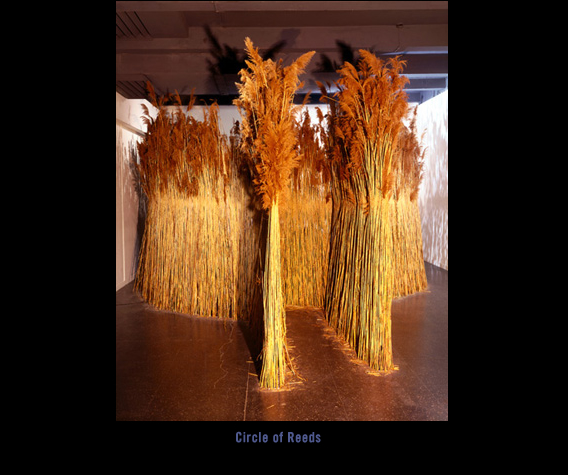








This work makes palpable the experiences that women face everyday, the double think that is necessary for our survival and the residue left after a rape. Rape is not an isolated action that occurs and then ends, but is instead an extreme violation of the person that is very difficult to forget and overcome. Through the use of objects, video and sound, the feelings women experience as a result of this very violent crime take form, creating a situation where the
perceiver can better understand just how violent a crime rape is and how the effects resonate
in the minds of the victims. We must be able to live without constant fear of being attacked, brutalized and raped.
Inside the two gallery spaces are two distinct yet connected installations. The first room is filled with the sounds of nature: birds singing, crickets chirping, the sound of the wind rustling leaves, creating a relaxing atmosphere. The central element in the gallery at first appears to be a very large pile of cane or reeds. The reeds are arranged to form a bower -- the nest built by the male bower, native to Australia and New Zealand. The entrance to the nest is a walkway into through the mound. The viewers enter the space and view the rusting back end of an old automobile, the backseat exposed. The backseat of an automobile is a highly charged site in our culture. It is the place where many women gave up their virginity, and the place where many violent attacks have taken place. Additionally, the issue of rape and its consequences has taken a backseat in our culture. We do not acknowledge or punish it. It is a crime that has been mostly silent throughout history. The viewer can climb into the backseat to hear a soundtrack that details a rape and its aftermath, told by a woman. The history is interjected with queries related to what a man's behavior and thinking might be after he rapes a woman. At the end of the soundtrack cycle an echoing voice says: "It could have been your wife. It could have been your daughter. It could have been your mother. It could have been your cousin. It could have been your girlfriend. It could have been your sister. It could have been your aunt. It could have been your grandmother."
In the second gallery are three private peepshow booths with separate entrances, each containing a video monitor, an audio track and a pull down seat. There are three video channels, one for each booth, each with its own soundtrack. The video in the first booth is shot from the point of view of a woman: checking through her apartment or house, looking under beds and in closets, running frightened down a dingy staircase and some images from the street. The camera occasionally glances behind itself, as though trying to escape from someone who is following it. The audio channel in this booth is taken from interviews with women regarding their rapes. The second booth has a videotape of women's names scrolling over images of girls and young women. The soundtrack intones more names. There are 1000 names in all. The third video is again shot from the point of view of a woman, this time moving through the streets at night. This is mixed with images of women in different social settings. The images create a disturbing sense of disembodiment. The soundtrack for this piece includes women telling how their family and loved ones reacted to their rapes and what the ramifications of the rapes were over the course of years. Each videotape runs seven minutes and is placed on a continuous loop.
1994